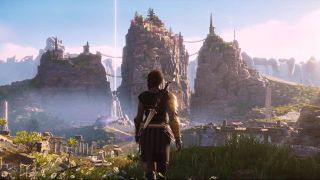What resolution are Stadia games really running at?
We asked Google, and game developers, whether their games are actually running at 4K.

Google's Stadia has been called "the best of PC and the best of console," and it is true that it combines convenience with up to 4K performance—even if, right now, it's missing features and prone to latency issues. But as we've mentioned in our testing of Stadia, its games lack the graphics settings menus of their PC counterparts. Worse, Stadia's 4K streaming doesn't actually mean its games are running at 4K.
Here's what Bungie told The Verge, when it asked what resolution Destiny 2 was running at: "'When streaming at 4K, we render at a native 1080p and then upsample and apply a variety of techniques to increase the overall quality of effect,' a Bungie rep said, adding that D2 runs at the PC equivalent of medium settings."
According to a Google presentation earlier this year, a Stadia server has about 10.7 teraflops of GPU power, which puts its graphics processing roughly on par with a GTX 2080. Based on our past testing, that should be enough to run Destiny 2 at 4K, 60 fps, with high or maxed settings.
As Digital Foundry points out, Rockstar's Red Dead Redemption 2 runs at between 1080p and 1440p as well, a far cry from 4K. While it's a demanding game that would struggle to run at 4K max settings on a high-end PC, the Stadia version is not even up to the bar set by the Xbox One X: "Red Dead 2 on Stadia doesn't seem to be delivering on key marketing promises - certainly not the spirit of them at least. At the reveal, we were told that Stadia's GPU has the power of Xbox One X and PS4 Pro graphics combined, yet RDR2 on Stadia only has 44 percent of the X's rendering resolution, while even the 4.2TF PS4 Pro GPU is generating a higher pixel-count (even before factoring in its checkerboarding upscale)."
So what's up?
I emailed representatives for Ubisoft, Square Enix, Bethesda, Warner Bros., Rockstar, and the publishers of other Stadia launch games to ask what resolution their games ran at. I also asked how they compared to PC graphics settings. Almost none provided comment by press time, or they deferred to Google to answer. A Google representative said they would provide a statement by Friday, but that statement didn't arrive until today.
After 9to5Google wrote an article titled "Google Stadia is lying about 4K games quality," Google responded to that criticism and provided PC Gamer with the same statement.
The biggest gaming news, reviews and hardware deals
Keep up to date with the most important stories and the best deals, as picked by the PC Gamer team.
"Stadia streams at 4K and 60 FPS - and that includes all aspects of our graphics pipeline from game to screen: GPU, encoder and Chromecast Ultra all outputting at 4k to 4k TVs, with the appropriate internet connection. Developers making Stadia games work hard to deliver the best streaming experience for every game. Like you see on all platforms, this includes a variety of techniques to achieve the best overall quality. We give developers the freedom of how to achieve the best image quality and framerate on Stadia and we are impressed with what they have been able to achieve for day one.
We expect that many developers can, and in most cases will, continue to improve their games on Stadia. And because Stadia lives in our data centers, developers are able to innovate quickly while delivering even better experiences directly to you without the need for game patches or downloads."

Publishers letting Google answer for them makes it hard to understand who, exactly, is ultimately responsible for how games run on Stadia, or how involved their original development teams are. Google's statement says it expects developers will "continue to improve their games on Stadia," but at least when it comes to PR, developers are letting Google speak to the technical qualities of their own games.
Unlike the other publishers I reached out to, Ubisoft did provide helpful comments from the development teams.
For Just Dance:
"Just Dance 2020 runs on 60FPS and in 4K on Stadia. On Xbox One and PlayStation 4 we are at 60FPS but not in 4K. Song videos are not in 4K, but the quality is the same across Stadia, X1 and PS4."
For Assassin's Creed Odyssey:
"When using 4K gamelets (Stadia supports both HD and 4K gamelets, and which one is used depends on a mix of factors including the player’s Stadia subscription plan and their device capabilities), the game does render at 4K. However, as when rendering in 4K on PC or high-end consoles, we do use dynamic resolution with temporal anti-aliasing to maintain a consistent framerate."
Assassin's Creed Odyssey running at 4K with dynamic resolution could mean the game is often running at a substantially lower resolution than 3840x2160—hard to say without extensive testing. It also doesn't specify what kind of settings the game is running at, which could be substantially lower than what the PC version is capable of.
"Gamelet" is a little-used term that I had to look up, myself, but it refers to the hardware Stadia runs its games on. You can read a little bit about that technology here, but not how Google is using it specifically for Stadia. That information isn't currently available, but makes me wonder if Stadia's games aren't taking full advantage of the processing power we expected because each gamelet is actually running more than game at a time. Maybe not—maybe Stadia's ports simply aren't yet optimized for the hardware they're running on. I've asked Google for more details and will follow up if I receive a reply.
Stadia's official marketing line has been "up to 4K 60 FPS gameplay," which many gamers understood to mean games running at 4K resolution, not just a 4K video stream. With the limited data provided in the Stadia app and in games themselves, there's no easy way to know what fidelity a game is being rendered at, but it's safe to say at this point many are not rendered at native 4K. That distinction may have been hard to explain in marketing, but the end result is another way Stadia's launch has gotten off on the wrong foot with its earliest adopters.

Wes has been covering games and hardware for more than 10 years, first at tech sites like The Wirecutter and Tested before joining the PC Gamer team in 2014. Wes plays a little bit of everything, but he'll always jump at the chance to cover emulation and Japanese games.
When he's not obsessively optimizing and re-optimizing a tangle of conveyor belts in Satisfactory (it's really becoming a problem), he's probably playing a 20-year-old Final Fantasy or some opaque ASCII roguelike. With a focus on writing and editing features, he seeks out personal stories and in-depth histories from the corners of PC gaming and its niche communities. 50% pizza by volume (deep dish, to be specific).
Most Popular


